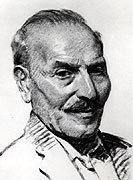Name George Papashvily Role Writer | Movies Anything Can Happen | |
 | ||
Spouse Helen Papashvily (m. 1933) Books Anything can happen, Russian Cooking, The Cooking of Russia | ||
Beauty in Stone
George Papashvily (Georgian: გიორგი პაპაშვილი; August 23, 1898 - March 29, 1978) was a Georgian-American writer and sculptor.
Contents
Life
He was born in the village of Kobiaantkari in the Dusheti District, Mtskheta-Mtianeti region of eastern Georgia. According to his autobiography, he apprenticed as a swordmaker and ornamental leatherworker. After service as a sniper in the Russian army in World War I, he immigrated to the U.S. in the early 1920s, and thereafter lived and worked in the U.S. Papashvily succeeded both as a sculptor and as an author; he was also a gifted engineer and inventor.
He met and married an American, Helen Waite (1906-1996). Together they wrote several books, often based on his life experiences. Their first book was Anything Can Happen (1945), which recounted Papashvily's experiences as a penniless immigrant. Originally published in a serialized format in Common Ground and Direction magazines, this book was co-selected for the Book of the Month Club and was a best-seller, selling more than 600,000 copies in the U.S. and 1.5 million worldwide. It was translated into 15 foreign languages, including Georgian (in 1966). It was made into a movie in 1952, starring Jose Ferrer as George and Kim Hunter as Helen. Papashvily died in 1978 in Cambria, California.
Works
Some other books by the Papashvilys were
Thanks to Noah was also published in Georgian (in 1971).
Art
With no formal training, Papashvily began carving in 1940. He soon developed a signature style that was a combination of naive and modern. He carved directly in wood and stone, sculpting free-standing figures and bas relief. His favorite subjects came from nature: animals, flowers, and an occasional human figure. Among his most famous works are:
Papashvily exhibited widely in solo exhibitions and with painters who were his friends.
